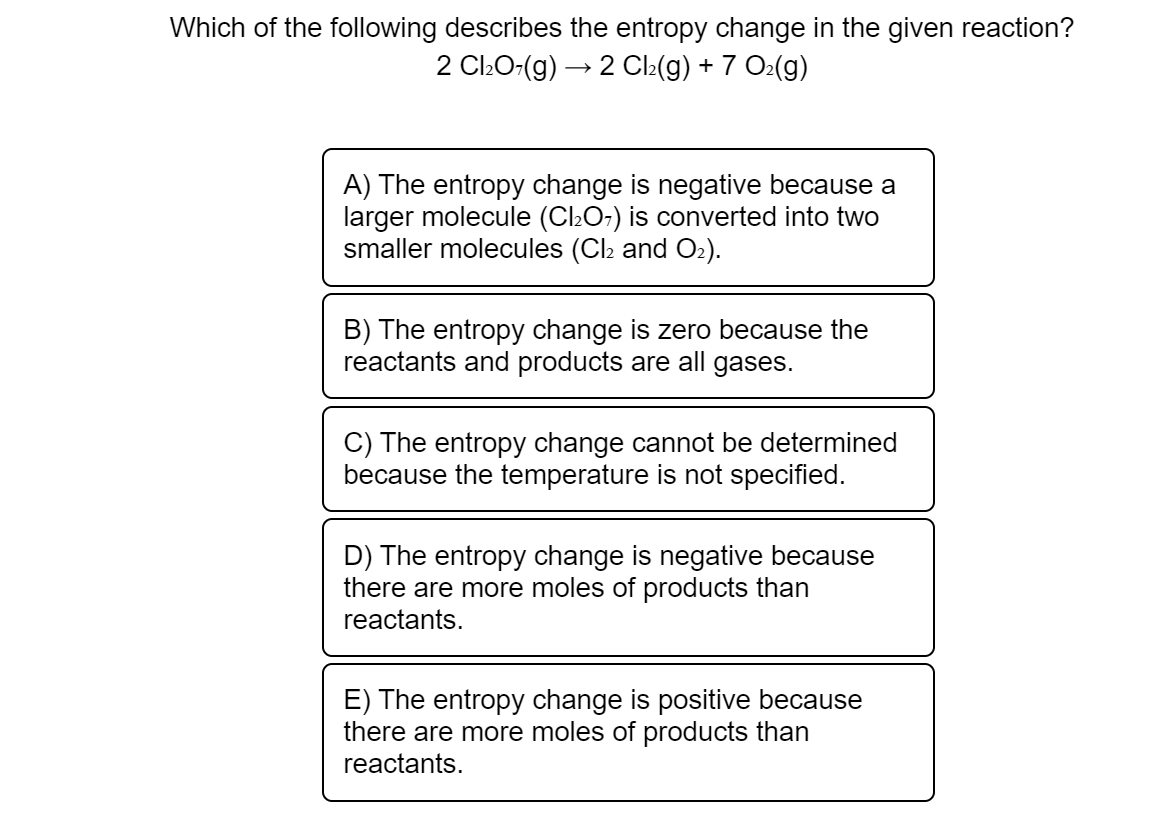Which of the following describes the entropy change in the given reaction? 2 ClO-(g) → 2 Cl2(g) + 7 O2(g) A) The entropy change is negative because a larger molecule (C2O-) is converted into two smaller molecules (C2 and O2). B) The entropy change is zero because the reactants and products are all gases. C) The entropy change cannot be determined because the temperature is not specified. D) The entropy change is negative because there are more moles of products than reactants. E) The entropy change is positive because there are more moles of products than reactants.
Which of the following describes the entropy change in the given reaction? 2 ClO-(g) → 2 Cl2(g) + 7 O2(g) A) The entropy change is negative because a larger molecule (C2O-) is converted into two smaller molecules (C2 and O2). B) The entropy change is zero because the reactants and products are all gases. C) The entropy change cannot be determined because the temperature is not specified. D) The entropy change is negative because there are more moles of products than reactants. E) The entropy change is positive because there are more moles of products than reactants.
General Chemistry - Standalone book (MindTap Course List)
11th Edition
ISBN:9781305580343
Author:Steven D. Gammon, Ebbing, Darrell Ebbing, Steven D., Darrell; Gammon, Darrell Ebbing; Steven D. Gammon, Darrell D.; Gammon, Ebbing; Steven D. Gammon; Darrell
Publisher:Steven D. Gammon, Ebbing, Darrell Ebbing, Steven D., Darrell; Gammon, Darrell Ebbing; Steven D. Gammon, Darrell D.; Gammon, Ebbing; Steven D. Gammon; Darrell
Chapter18: Thermodynamics And Equilibrium
Section: Chapter Questions
Problem 18.120QP
Related questions
Question
100%

Transcribed Image Text:Which of the following describes the entropy change in the given reaction?
2 ClŁO-(g) → 2 Cl2(g) + 7 O2(g)
A) The entropy change is negative because a
larger molecule (C2O-) is converted into two
smaller molecules (Cl2 and O2).
B) The entropy change is zero because the
reactants and products are all gases.
C) The entropy change cannot be determined
because the temperature is not specified.
D) The entropy change is negative because
there are more moles of products than
reactants.
E) The entropy change is positive because
there are more moles of products than
reactants.
Expert Solution
This question has been solved!
Explore an expertly crafted, step-by-step solution for a thorough understanding of key concepts.
This is a popular solution!
Trending now
This is a popular solution!
Step by step
Solved in 2 steps

Knowledge Booster
Learn more about
Need a deep-dive on the concept behind this application? Look no further. Learn more about this topic, chemistry and related others by exploring similar questions and additional content below.Recommended textbooks for you

General Chemistry - Standalone book (MindTap Cour…
Chemistry
ISBN:
9781305580343
Author:
Steven D. Gammon, Ebbing, Darrell Ebbing, Steven D., Darrell; Gammon, Darrell Ebbing; Steven D. Gammon, Darrell D.; Gammon, Ebbing; Steven D. Gammon; Darrell
Publisher:
Cengage Learning

Chemistry & Chemical Reactivity
Chemistry
ISBN:
9781133949640
Author:
John C. Kotz, Paul M. Treichel, John Townsend, David Treichel
Publisher:
Cengage Learning

Chemistry & Chemical Reactivity
Chemistry
ISBN:
9781337399074
Author:
John C. Kotz, Paul M. Treichel, John Townsend, David Treichel
Publisher:
Cengage Learning

General Chemistry - Standalone book (MindTap Cour…
Chemistry
ISBN:
9781305580343
Author:
Steven D. Gammon, Ebbing, Darrell Ebbing, Steven D., Darrell; Gammon, Darrell Ebbing; Steven D. Gammon, Darrell D.; Gammon, Ebbing; Steven D. Gammon; Darrell
Publisher:
Cengage Learning

Chemistry & Chemical Reactivity
Chemistry
ISBN:
9781133949640
Author:
John C. Kotz, Paul M. Treichel, John Townsend, David Treichel
Publisher:
Cengage Learning

Chemistry & Chemical Reactivity
Chemistry
ISBN:
9781337399074
Author:
John C. Kotz, Paul M. Treichel, John Townsend, David Treichel
Publisher:
Cengage Learning

Chemistry for Engineering Students
Chemistry
ISBN:
9781285199023
Author:
Lawrence S. Brown, Tom Holme
Publisher:
Cengage Learning

Chemistry for Engineering Students
Chemistry
ISBN:
9781337398909
Author:
Lawrence S. Brown, Tom Holme
Publisher:
Cengage Learning

Chemistry: The Molecular Science
Chemistry
ISBN:
9781285199047
Author:
John W. Moore, Conrad L. Stanitski
Publisher:
Cengage Learning